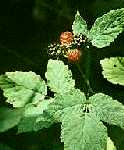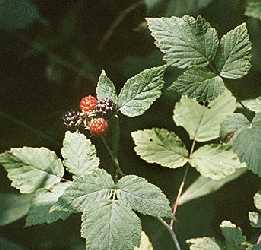 BLACKBERRY: Names and Photo ID's
BLACKBERRY: Names and Photo ID'sJump to Page Navigation Buttons===>>

 |
Blackberries come in many species and varieties. Katsi doesn't give us the Mohawk name. Ojibwe women call them all Odatagago minagawunj, that is, black berry. Nuu-Chah-Nuth peoples of the Northwest Coast tribes on Vancouver Island, BC, distinguish two kinds: Chismapt, a trailing, vine-like berry that grows in rocky, dry, open sites, and the bush blackberry, which resembles red raspberry plants: : hisshitlmapt. Black raspberries look like the ID photo at the left. |
|---|---|
There are other types of blackberries -- which are members of the Rose family, Rosaceae, with a genus name of Rubus and various species names. Robus frondosus and Rubus occidentalis are the two types commonest in Minnesota and Wisconsin. |
 |
The photo shows a common wild type, whose fruit is borne differently from the black raspberry type. This type of blackberry forms large, thick tangles, higher than a person's head. Because of the bramble thorns, only thick-coated bears (of thickly-dressed, determined types) can gather the blackberries that grow toward the centers of such thick tangles. Another type of berry -- sometimes called Dewberry -- grows on trailing vines, rather than woody canes. Depending on the species and how far north you are, blackberries begin to flower with large white blossoms in early spring, with fruit ripening through late summer and early fall. The commonest type of wild blackberries -- like the ones shown above -- have white, woody stems that extend almost through the berry. Very ripe berries pulled off the stems will break apart into the small, round parts of the berry, each containing a seed. In making jams or jellies, it's better to crush and force booked berries through a sieve, to get rid of at least some of the seeds.
Teas made of fresh leaves should use very fresh, unwilted leaves crushed, about 2 tablespoons of crushed fresh leaf per pint of boiling water, steeped 15 minutes, the strained.. Otherwise, leaves to make tea should be fully dried in shade and 1 to 2 teaspoons per cut of boiling water steeped for 15 minutes. Some blackberry recipes are on the Recipes page. Former uses of blackberry plant teas for women's medical purposes have been almost entirely replaced by use of red raspberry plant teas, since the discovery that there is a uterine relaxant in raspberry leaf and bark/root teas apparently not found in blackberry plants. | |

Analysis of the nutritional and phytochemical content of blackberries -- nutritional comparison of several species with red reaspberry and commercial fresh orange.
Table of multi-tribal uses of blackberry plants (usually leaves, bark, or roots) for medical uses. [Apparently never done.]

 Plants Plants MENU |
|---|

CREDITS: Most photos are from the University of Wisconsin (Madison) botany gopher. The large Texas pink blackberry flower, and its associated berries, were photographed by J.R. Manhart, for the TAMU Botany Department Herbarium image gallery.
Webmistress --Paula Giese.Text and graphics copyright 1996.
Last Updated: Monday, January 15, 1996 - 2:54:01 AM